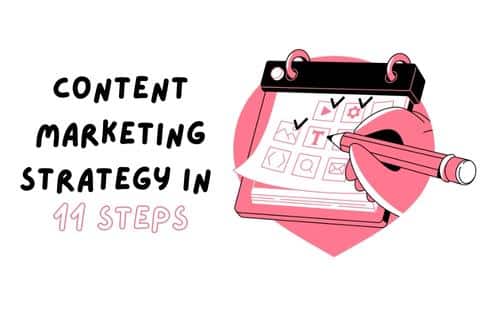- March 20, 2023
- techAdmin
- 0
Master Your Content Marketing Strategy in 2023: The Ultimate Guide
Did you know that 63 percent of companies lack a written content marketing strategy? That’s according to the most recent research from Marketing Profs and the Content Marketing Institute (CMI).
It should come as no surprise that content marketing efforts are more likely to be successful for businesses with a plan.
If you don’t have a plan, success or failure will be luck, and you risk wasting all your efforts. This guide will show you how to create and implement a content marketing strategy in 11 steps to help you grow your business without wasting time or money.
The Ultimate Guide to Win your Content Marketing Strategy

For your convenience, the steps are as follows:
Step 1. Set Your Content Strategy goal
Step 2: Decide on Your Purpose and Objectives
Step 3: Establish Your KPIs
Step 4: Get to Know Your Audience
Step 5: Evaluate Your Present Position
Step 6: Choose the Best Content Channels
Step 7: Select the Types of Content
Stage 8: Recognize and Apportion Assets
Step 9: Make a Content Calendar
Step 10: Content Creation
Step 11: Market your Content and Measure the result
Step 1. Set Your Content Strategy goal
Setting brief and measurable content goals is essential to any effective content marketing strategy. Your content strategy goals should align with your overall business objectives and help you achieve specific results, such as increasing brand awareness, generating leads, or driving sales.
Your goals should also be specific, realistic, and time-bound so that you can track progress and adjust your strategy accordingly. By setting clear content strategy goals, you can ensure that your efforts are focused and that you invest resources wisely.
Ultimately, a well-defined content strategy goal will help you create content that reverberates with your target audience, drives engagement, and delivers tangible results for your business.
Step 2: Decide on Your Purpose and Objectives
Before embarking on a content marketing strategy, it’s crucial to determine your purpose and objectives. Content marketing aims to attract, engage, and retain a target audience by creating valuable and relevant content that solves their problems and addresses their needs.
Your content objectives should align with your overall business goals, including increasing website traffic, generating leads, improving brand awareness, or driving sales. Without clear objectives, it cannot be easy to measure the effectiveness of your content marketing efforts.
Therefore, take the time to establish your purpose and objectives before developing your content marketing strategy to ensure that you’re creating content that serves a specific purpose and drives tangible results for your business.
Step 3: Establish Your KPIs
Setting clear Key Performance Indicators (KPIs) is essential when creating a successful content marketing strategy. KPIs are specific, measurable goals that allow you to track the success of your content marketing efforts over time.
They can include metrics such as website traffic, social media engagement, lead generation, conversion rates, and more. By establishing KPIs at the beginning of your content marketing strategy, you can align your efforts with your business goals and ensure that your content drives results.
Regularly tracking and analyzing your KPIs can also help you to identify areas where you can improve your content and optimize your strategy for better performance. Establishing KPIs is crucial to creating a data-driven content marketing strategy that delivers measurable results.
Step 4: Get to Know Your Audience
In content marketing, understanding your audience is crucial to creating compelling content that resonates with them. To get to know your audience, you should identify their needs, preferences, and interests.
This can be achieved through research, such as surveys, focus groups, and social media analytics. By gathering data on your audience, you can create buyer personas representing your ideal customers and tailor your content to meet their needs.
Additionally, you should monitor the engagement and feedback from your audience to refine your content marketing strategy continuously. Knowing your audience allows you to create content that directly conveys their needs and desires, increasing engagement and conversion rates.
Step 5: Evaluate Your Present Position
As a content marketer, evaluating your present position is crucial to determining the effectiveness of your current content marketing strategy. Reviewing your content goals, target audience, and the channels you use to distribute your content is essential.
Analyzing your website traffic, engagement rates, and social media metrics can also give you a clear picture of your content’s performance. A closer look at your competitors’ content marketing strategies can provide valuable insights and improvement opportunities.
By evaluating your current position, you can identify areas for growth, optimize your content, and adjust your strategy to reach better and engage with your target audience.
Step 6: Choose the Best Content Channels
Choosing the best content channels is essential in developing a successful content marketing strategy. Various channels are available, including social media platforms, email marketing, blogs, video marketing, podcasts, and more.
To select the proper channels for your brand, it’s essential to consider your target audience and where they spend their time online. For example, visual content on this platform may be the best option if your audience is active on Instagram.
A blog or podcast may be better if your audience is more interested in in-depth content. Additionally, it’s essential to consider the type of content you create and which channels are best suited for it.
Video content may perform well on YouTube or TikTok, while shorter text-based content may be more effective on social media platforms like Twitter or LinkedIn. Selecting the proper channels ensures your content reaches your intended audience and is optimized for engagement and conversion.
Step 7: Select the Types of Content
Selecting the types of content to include in your content marketing strategy is an important decision that can impact the success of your campaign. There are numerous content types, including blog posts, articles, videos, infographics, whitepapers, e-books, podcasts, webinars, and more.
Your content types should align with your marketing goals and target audience preferences. For example, if you want to educate your audience about a complex topic, a whitepaper or e-book may be the best fit.
A visually appealing infographic or video may be more effective in increasing engagement and shareability. Additionally, it’s essential to consider the stage of your audience’s customer journey and select content types that can move them toward conversion.
Stage 8: Recognize and Apportion Assets
Recognizing and apportioning assets is essential in developing a successful content marketing strategy. Support can include anything that adds value to your content, such as images, videos, blog posts, social media posts, customer testimonials, and more.
To effectively apportion these assets, it’s essential to identify which ones are most valuable for achieving your marketing goals and reaching your target audience. For example, if your target audience is active on social media, allocating resources toward social media marketing may be the most effective way to reach them.
Similarly, incorporating a wealth of customer testimonials into your content can help build trust and credibility with your audience. By recognizing and apportioning your assets, you can leverage your strengths.
Step 9: Make a Content Calendar
Making a content calendar is essential to creating a successful content marketing strategy. A schedule that specifies when, where, and what kind of content you will produce is known as a content calendar.
It allows you to plan and organize your content in advance, ensuring that you are consistently producing high-quality content that aligns with your marketing goals. Create a content calendar to identify dates and events relevant to your business and audience.
Then, determine the frequency of your content creation and which types of content you will produce. Finally, schedule your content across different channels, including social media, website, and email marketing.
A well-planned content calendar can help you stay organized, ensure your content is on-brand and on-message, and provide opportunities for cross-promotion and increased engagement with your audience.
Step 10: Content Creation
Content creation is at the heart of any successful content marketing strategy. It entails creating high-quality, engaging, instructive content that connects with your target audience and creates outcomes for your company.
To create compelling content, you must first identify your target audience and understand their interests, pain points, and motivations. This information can then inform the type of content you create and your messaging.
Your content must also be optimized for search engines by incorporating relevant keywords and following on-page optimization best practices.
In addition, adding multimedia components like images, videos, and infographics to your content can increase its share ability and engagement. Ultimately, content creation aims to provide value to your audience and build a relationship of trust and credibility with them.
By producing content of high quality that speaks directly to your intended audience, you can effectively communicate your brand’s message and achieve your marketing goals.
Step 11: Market your Content and Measure the result
Marketing your content and measuring the results are critical steps in any successful content marketing strategy. After creating your content, promoting it through various channels such as social media, email marketing, guest posting, and paid advertising is essential.
Effective content promotion requires understanding your target audience and where they spend their time online. You can use various marketing channels to make your content more visible and reach a larger audience.
It is essential to keep track of metrics like website traffic, engagement rates, social media metrics, and conversion rates to evaluate the success of your content marketing campaigns. You can determine which types of content resonate with your audience and adjust your strategy accordingly by monitoring these metrics.
Additionally, analyzing your competitors’ content marketing efforts can provide valuable insights into the types of content that are performing well in your industry. By marketing your content effectively and measuring the results, you can optimize your content marketing strategy and achieve your marketing goals.
The ultimate measure of the effectiveness of a content marketing strategy is the results it produces. If ZabTech IT Solution’s content marketing efforts are achieving its marketing goals, such as increasing website traffic, generating leads, or improving brand awareness, it can be considered a successful strategy.
Therefore, by evaluating these factors, it can be determined whether ZabTech IT Solution has a good content creation company in Dubai.


